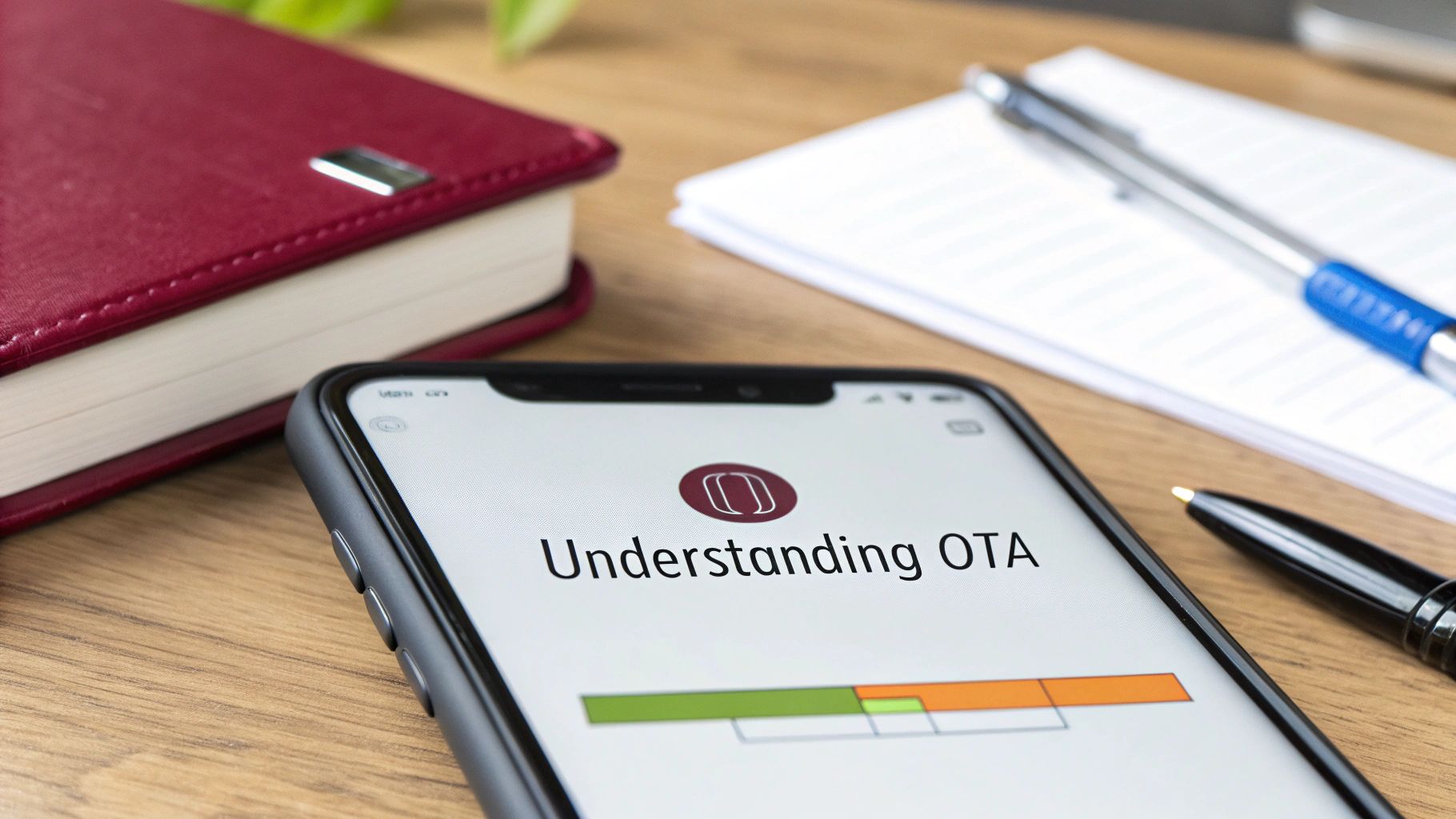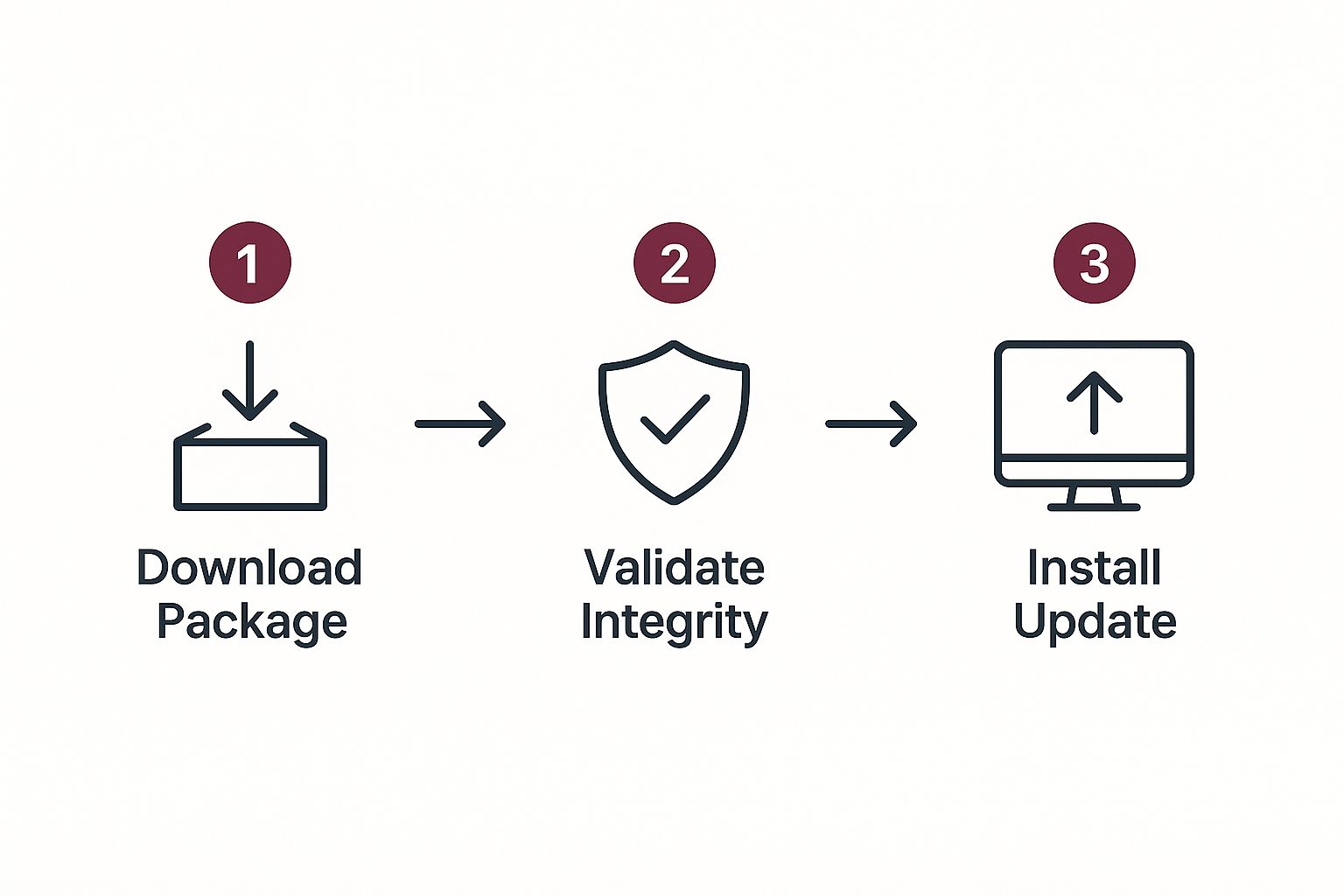Ever had your phone update itself overnight while plugged in and connected to Wi-Fi? That’s an Over-the-Air (OTA) update in action. It’s the magic of wirelessly sending new software, firmware, or other data straight to your devices, no cables required.
Think of it as a remote upgrade. Whether it’s for your phone, your car, or even your smart TV, this process ensures your tech stays current, secure, and running smoothly without you having to lift a finger.
What Is an OTA Update Explained Simply

Let’s go back to that smartphone example. You get a notification that a new software version is ready. You tap “Install,” and the device handles the rest over your Wi-Fi network. When you wake up, you’ve got new features, better performance, and crucial security fixes. That seamless experience is the heart of an OTA update.
This is a world away from the old days. We used to have to physically connect devices to a computer with a USB cable just to run a software update. Thankfully, OTA technology has made that process obsolete and is now the gold standard for virtually every connected device we own.
The Standard for Modern Technology
OTA updates are no longer just a “nice-to-have” feature; they are absolutely essential. They create a direct line of communication from the manufacturer to the user, allowing for continuous product improvements long after the initial purchase.
The advantages are pretty clear:
- Instant Improvements: Users get the latest features and bug fixes without waiting for a major release.
- Enhanced Security: Critical vulnerabilities can be patched across millions of devices almost instantly, keeping user data safe.
- Ultimate Convenience: Updates are pushed out wirelessly and often install in the background with little to no effort from the user.
This isn’t just about consumer gadgets. The automotive industry heavily relies on OTA updates to improve vehicle performance, roll out new infotainment features, and even handle safety recalls without forcing drivers to visit a dealership.
For those of us in the app development world, mastering the nuances of OTA updates for Android and iOS is a must. It’s our secret weapon for deploying small fixes and UI tweaks, letting us skip the often lengthy app store review process. This kind of agility is what separates good apps from great ones in today’s competitive market.
For a clearer picture, let’s break down how OTA updates stack up against the old-school manual approach.
OTA Updates vs Traditional Updates At a Glance
The table below offers a quick comparison, showing the key differences between modern Over-the-Air updates and the manual methods we used to rely on. It really highlights why OTA has become the default for nearly every connected device.
| Feature | OTA (Over-the-Air) Update | Traditional (Manual) Update |
|---|---|---|
| Delivery Method | Wireless (Wi-Fi, Cellular) | Physical connection (USB cable) |
| User Effort | Minimal (often just a tap) | High (requires PC, software, and time) |
| Deployment Speed | Instant and scalable to millions | Slow and individual |
| Convenience | High; can happen automatically | Low; requires user to initiate and manage |
| Security Patches | Fast and widespread | Slow and depends on user action |
| Use Cases | Smartphones, cars, IoT, apps | Legacy devices, firmware flashing |
As you can see, OTA updates provide a faster, more secure, and vastly more convenient way to keep technology current. This shift has fundamentally changed how we manage and improve software for the better.
How OTA Updates Actually Work Behind the Scenes
Ever wondered what’s really happening when your phone prompts you to install an update? It’s not magic—it’s a carefully choreographed process happening quietly in the background. Think of it like a highly efficient delivery service.
It all starts with a central server, which is basically a secure warehouse holding the latest software package. Your device—be it a smartphone, a smart TV, or even your car—is designed to periodically ping this server to ask, “Anything new for me?”
When the server gets this request, it checks your device’s credentials—its model, current software version, and maybe even its region. If there’s a match, the server gives the green light and begins sending the update package over a secure connection, like Wi-Fi or your cellular network. This isn’t just a blind file transfer; it’s a managed, step-by-step operation.
The Three-Stage Journey of an Update
To ensure everything goes smoothly and securely, the update travels through a precise, three-stage journey from the server to your device. Most of this happens without you even noticing, right up until it’s time to hit “install.”
-
Download Phase: First, the device downloads the update package. This often happens in the background, broken into small chunks so it doesn’t hog your bandwidth or interrupt what you’re doing. Many systems are smart enough to pause the download on a weak signal and pick it back up when the connection improves.
-
Verification Phase: This is a crucial security step. Before even thinking about installation, your device runs an integrity check. It uses a digital signature to confirm the update is genuinely from the manufacturer and hasn’t been tampered with. It’s like checking the security seal on a package before opening it.
-
Installation Phase: Once the update is verified, it’s ready to be installed. This is usually the only part you see, often requiring a restart. During this reboot, the new software replaces the old. Many modern devices use a clever technique called A/B partitioning, where the update installs onto a separate, inactive system partition. If anything goes wrong, your device can simply boot back into the old, stable version—a fantastic safety net.
This diagram helps visualize the simple, yet powerful, sequence every OTA update follows.

This dependable flow—from download to verification to installation—is what makes OTA updates so convenient, reliable, and secure. It’s a system designed to ensure a corrupted or malicious file never makes it onto your device.
The Key Benefits of OTA Updates for Everyone

The rise of Over-the-Air updates isn’t just a tech trend; it’s a huge shift in how products are maintained and improved, with clear wins for everyone. As users, we feel the benefits directly. It’s the simple convenience of a device getting smarter on its own, often while we sleep.
This hands-off process means we get the newest features right away. More importantly, it delivers critical security patches to shield our data from new threats. The days of plugging your device into a computer for a clunky manual update are long gone.
For the companies behind these products, the advantages are just as powerful. OTA technology leads to major cost savings by getting rid of the need for expensive product recalls just to fix a software bug. It also lets them innovate faster, which directly boosts customer happiness and keeps people loyal to the brand.
An OTA update is more than just a convenience; it’s a direct channel for continuous improvement. It allows a product to evolve, get safer, and become more capable long after it has been sold.
Driving Value in Modern Industries
The car industry is a perfect example of how much this technology matters. Today’s cars are basically software on wheels, and OTA updates are the only practical way to manage them. The global automotive OTA market was valued at $4.29 billion and is expected to keep growing, which shows just how vital it is. You can learn more about these automotive market trends on The Business Research Company.
With this technology, car manufacturers can:
- Enhance Vehicle Performance: Remotely fine-tune engine performance or improve an EV’s battery life.
- Deploy Safety Features: Push out improvements to driver-assist systems, making the roads safer for everyone.
- Add New Functionality: Introduce new entertainment apps or refresh the user interface without anyone needing to visit a dealership.
For app developers, the benefits are very similar. Setting up automatic app updates means you can fix bugs and launch new features in a flash, skipping the slow app store review process. This keeps your users happy with an app that is always getting better. You can see how to implement automatic app updates in our detailed guide. This direct pipeline to your users’ devices is an essential tool for keeping your app secure, modern, and high-quality.
OTA Updates in Action Beyond Phones and Cars
When you think of OTA updates, smartphones and cars probably spring to mind. But the reality is, this technology is the quiet workhorse behind a huge number of the connected devices we rely on every day. It’s the unsung hero that keeps our digital world secure and constantly improving, long after we’ve bought it.
Take your smart home, for instance. Your smart TV suddenly has a new streaming service. Your thermostat gets a software tweak that makes it better at saving energy. Your security camera gets a critical patch to close a vulnerability. All these improvements are delivered silently and efficiently through Over-the-Air (OTA) updates. Without them, these gadgets would be stuck in time, becoming less useful and more risky.
Powering Our Connected World
The influence of OTA technology runs deep, especially in industrial and critical sectors where it’s become indispensable for managing complex networks of equipment.
- Industrial IoT (IIoT): Imagine a factory floor filled with sensors monitoring machinery or a global supply chain tracking packages. OTA updates are crucial for keeping these sensors accurate and secure, which helps prevent expensive shutdowns or lost goods.
- Healthcare Technology: In a hospital setting, vital equipment like infusion pumps or patient monitors can receive essential software updates remotely. This is a game-changer for patient safety and device effectiveness, as it avoids the need for a technician to physically handle every single machine.
The concept at its heart is beautifully simple: if a device is connected to the internet, it can be updated, fixed, and improved from anywhere. This single capability is what makes the entire Internet of Things (IoT) ecosystem possible to manage on a massive scale. You can learn more about how Over-the-Air updates are shaking up various industries right here on our blog.
The market for this technology is growing fast. The global OTA market, spanning everything from consumer electronics to industrial IoT, was recently valued at around $3.2 billion. North America is currently leading the pack, largely thanks to its robust digital infrastructure. For a deeper dive into these numbers, you can explore the full report on Cognitive Market Research.
This chart from their report breaks down the market share by region.
As you can see, North America’s significant slice of the pie highlights just how widely connected devices have been adopted there, backed by serious investment in the technologies that make large-scale OTA updates a reality.
Keeping OTA Updates Safe and Secure

There’s no denying how convenient wireless software updates are. But with that power comes a serious responsibility: security. Since an OTA update modifies your application’s code directly on a user’s device, it can become a tempting target for attackers if not properly secured. A compromised update could lead to massive disruptions, from data breaches to widespread app crashes.
A good way to think about it is like a bank sending cash in an armored truck. The cargo is extremely valuable, and everyone knows the route it’s taking. You wouldn’t just send it in a regular car, right? The same logic applies here. The “armored truck” for a software update is a set of strong security protocols that protect it every step of the way.
The Pillars of OTA Security
The entire security model for OTA updates rests on two simple but crucial ideas: proving the update came from a trusted source and protecting the update itself while it travels. Without these two pillars, the risk would be far too great, and we wouldn’t have the seamless, automatic updates we rely on today.
For any development team, a solid grasp of what is the OTA update process and its security measures is absolutely essential. You can learn more about the fundamentals here: https://codepushgo.com/blog/what-is-ota-update/
Let’s break down the core defenses that make this all work.
-
Digital Signatures: Think of this as the official, tamper-proof seal on the update package. Before your app even tries to install the new code, it checks this unique cryptographic signature. This check confirms two things: that the update is genuinely from you (the developer) and that it hasn’t been messed with. If the signature is invalid or missing, the device flat-out rejects the update.
-
End-to-End Encryption: This is what keeps the update package safe during its journey from the server to the device. The entire package is scrambled into unreadable code. Only the user’s device has the specific key needed to unscramble it. This means that even if someone manages to intercept the update file, it’s completely useless to them.
A failed update can be more than just an annoyance—it can render an app or device totally useless, a state often called “bricked.” This is why modern OTA systems have built-in fail-safes. Many use a technique called A/B partitioning, which keeps a copy of the old, stable version ready. If the new update fails for any reason, the device can simply roll back to the one that worked.
Common Questions About Over-the-Air Updates
Even after you get the hang of how OTA updates work, some practical questions always pop up. It’s totally normal to wonder about things like data usage, security, or what happens if an update goes sideways. Let’s tackle some of the most common ones to clear things up.
Getting these answers helps build trust in the whole process. Once you understand the built-in safeguards, you can really appreciate the power and convenience of OTA technology, whether it’s for your phone, your car, or the app you’re building.
Do OTA Updates Use My Mobile Data?
Yes, an over-the-air (OTA) update can use your cellular data if you’re not connected to Wi-Fi. But don’t worry, developers and device makers are very aware of this.
Most systems, like iOS and Android, are set up by default to download big updates only over Wi-Fi. This is a smart way to prevent an update from gobbling up your entire monthly data plan. You can almost always dive into your device settings to control this, making sure updates only happen when and how you want them to.
Is It Safe to Install Every OTA Update?
For the most part, absolutely. Official OTA updates from trusted sources like Apple, Google, or your app’s developer are more than just safe—they’re essential. They deliver critical security patches, fix annoying bugs, and often add cool new features.
The security protocols we talked about earlier, especially digital signatures, are there for a reason. They confirm the update is the real deal and hasn’t been messed with. The only time to be suspicious is if a notification looks off or comes from somewhere other than your device’s official update screen.
The real danger isn’t installing updates—it’s not installing them. Putting off an update leaves your device and your data vulnerable to security holes that have already been fixed.
What Happens If an OTA Update Fails?
Modern OTA systems are surprisingly tough. They’re designed with strong fail-safes for when things go wrong. If an update fails mid-installation—say, your battery dies or the download gets corrupted—the device won’t just give up.
It has a recovery plan. This “rollback” feature automatically reverts your device to the last stable version of the software, preventing it from getting “bricked” or becoming unusable. Once you’ve sorted out the issue (like charging your phone), you can simply try the update again. This kind of resilience is a cornerstone of solid software deployment best practices.
Can I Stop an OTA Update?
Most devices will let you hit the snooze button on an update for a while, but permanently blocking them is a bad idea. These updates are your first line of defense against new security threats.
While you might find some technical hacks to stop updates entirely, you’d be intentionally punching a hole in your device’s security net. This not only leaves you exposed but also means you’ll miss out on performance boosts and new features everyone else is getting. It’s almost always better to just install them.
For development teams that want to build a secure and reliable update process for their own apps, CodePushGo is a fantastic tool. Our platform puts you in the driver’s seat of your React Native updates, offering staged rollouts, instant rollbacks, and end-to-end encryption.
You can ship bug fixes and new features in minutes, not weeks. Take a look at CodePushGo to see how you can make your app updates smoother and safer starting today.




